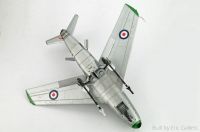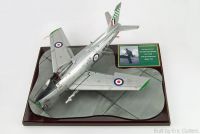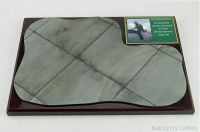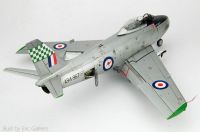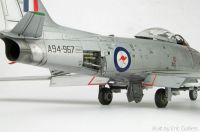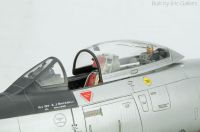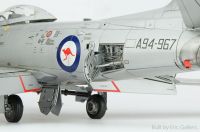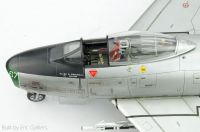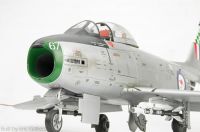Italeri 1/32 CAC Sabre, No. 77 SQN RAAF, Pilot Officer K. J. Bricknell, Malaya 1963
By Eric Galliers
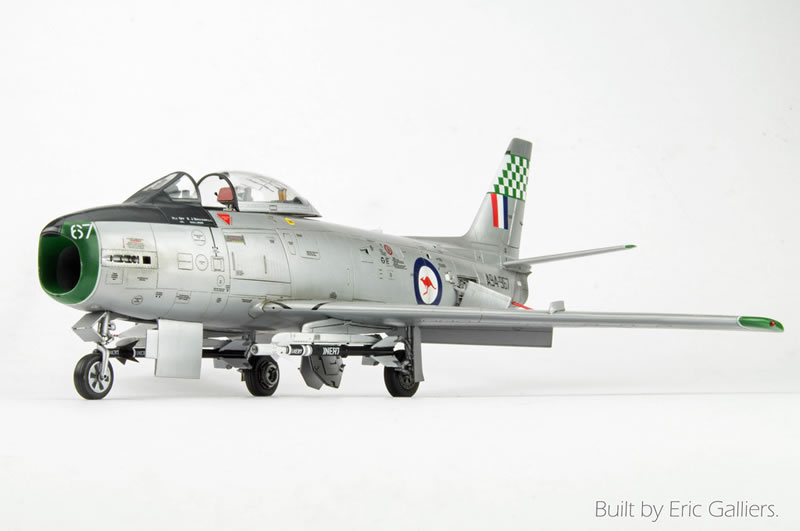
Here is my completed Italeri CAC Sabre.
The Kit
Highly modified Italeri F-86 Sabre converted to CAC Sabre spec. 3mm shims added to the depth of the intake and rest of fuselage blended into the modification to just forward of the wheel bays.
- All vents, grilles and ducts scratchbuilt
- Scratchbuilt rear of ejection seat
- Modified Aires cockpit
- Scratchbuilt cannon ports
- Modified nose wheel
Additions
- Aires Wheelbays
- Aires Speed brake wells
- AMS resin Wheels
- E-Resin AIM-9B sidewinders
- E-Resin Aero 3B missile rails
- Metal pitot tube
- Turned metal landing lights
- Southern Sky stencil data
- ALPS printed Serials and pilots name
- Custom masks for the rest of the markings
Many thanks go to Kevin Bricknell for his massive amounts of input to this project.
Firstly, a bit about Brick:
K. J. “Brick” Bricknell grew up on a farm in northern Tasmania. After finishing secondary school, he was sitting behind a drawing board in Launceston, wondering if he should pursue architecture as a career, when his best friend from schooldays (Eddie Blyth) rang and asked if he wanted to go for a fly. (Eddie had got his private pilot’s license just as soon as he was legally old enough to hold one.) So, on the following Saturday, Brick went for his first ever ride in an aircraft. Utterly entranced by the experience of riding in the front seat of a beautiful old Tiger Moth on a peerless summer day, he immediately decided on the direction he was going to take in life from that point.
After gaining his private pilot’s licence, he decided to apply for pilot training in the RAAF. Unfortunately, he was rejected on medical grounds, the examining ophthalmologist in Hobart declaring that he was just short-sighted enough in his right eye to be below the required RAAF standard. A second opinion by the civil aviation examiner in Launceston failed to sway the recruiting office, and so Brick decided to start out on training and study for a commercial pilot’s license.
Eventually, having gained his commercial license, he lit out for the mainland, hoping to break into a career in civil aviation. But the pickings in that era were very slim so, on a whim, he decided to try for the RAAF once more. The ophthalmologist in Melbourne called him back twice, but eventually decided that, although the right eye was borderline, he would allow him to go before the interview board. It wasn’t all that long after that that he entered pilot training at Point Cook as a cadet on No 35 Pilot’s Course.
The jet phase of his pre-wings training followed at Pearce in Western Australia. Brick still clearly remembers the excitement of seeing, for the first time, all those Vampire 35s lined up on the tarmac, and the sound of their engines winding up for the first student wave of the day. And, after his first flight with his instructor (LTCDR Bennie Matthews), he felt like sending that ophthalmologist in Melbourne a huge crate of French champagne. This, he concluded without a shred of reservation, was the life.
The RAAF was not exactly short of pilots in those days, and many of the students who entered No 35 Course dropped by the wayside, always a sad thing to see. However, Brick managed to survive and, in fact, finished up at the top of the graduation order. Since the fighter world always took pilot’s from the top of the wings graduation order, it was a given that Brick’s next destination would be the sacred turf of the Australian fighter pilot: RAAF Base Williamtown NSW. As you can imagine, he was absolutely devastated by this posting, as evidenced by the smile he couldn’t seem to remove from his countenance for days on end.
Before proceeding to the base irreverently referred to as “Knucksville" by those who regard fighter pilots as nothing more than immature and egotistical prima-donnas, Brick took a spot of leave in Tasmania, during which time he may or may not have rung that ophthalmologist in Hobart, advising him that he (Brick) had topped his course, and rather theatrically thanking him profusely for wasting eighteen months of his (Brick’s) life.
He still clearly remembers the impact of seeing a line of Avon Sabres for the first time as he got off the TAA flight at the civil terminal at Williamtown. There’s my new goal, he said to himself, relishing the prospect of eventually strapping one of those magnificent machines on every working day of his life. But, alas, it was going to be just over a year before he managed to do that, the reason being that incoming pilots had to spend quite some time on Vampire 35s at No 76 Squadron, which in those days was a sort of “holding” unit for pilots queued up for the Sabre operational conversion course.
Fortunately the day finally arrived (1 Jun 1961) when Brick strapped on an Avon Sabre for the first time, with an instructor (FLTLT Pete Larard) flying chase. As you are no doubt aware, there was no two-seat version of the Sabre, so your first solo was also your first flight. There was no opportunity to be introduced to the aircraft by an instructor sitting next to you or behind you. Brick says that the first flight in such circumstances is a bit weird because, despite all the preparation in the simulator, you still don’t know exactly what to expect. What he was expecting was a certain amount of exhilaration, and the Sabre really delivered on that. It was just like being in a high-end Jaguar, having recently been driving an Austin 7. He was so taken with it all that he was still wings level passing about a thousand feet after takeoff when Pete, who was given to making the odd sarcastic comment on occasion, transmitted “Go on Brick. Be a devil. Do a turn.”. Brick willingly obliged, and never looked back from that point on. The cockpit was hugely roomy and comfortable compared with the old Vampire, the view all round was superb thanks to the bubble canopy, and the bird handled beautifully.
The only other flight on his operational conversion course that Brick can clearly remember is his first close formation flight. Pete Larard was again the instructor. This was supposed to be a gentle introduction to close formation flying - nothing above 40 degrees of bank, and no high ‘G’ stuff. But, about 10 minutes into the mission, Brick began to suspect that Pete had decided to find out what he (Brick) was made of. Some of the rest of the mission comprised loops and barrel rolls, with Brick hanging on desperately in both echelons and line astern, with Pete calling station changes half way round those manoeuvres . Pete didn’t say anything at the debriefing, so Brick assumed that he had passed this unofficial test and proven that he really did deserve to sit “above the salt” at the Knucksville table - albeit on a probationary basis. (And, incidentally, it’s probably not relevant to mention all these years later that unauthorised formation aerobatics were simply not “legal”, even then.)
With the operational conversion completed, Brick found himself posted to No 77 Squadron at Butterworth in the then Malaya. This was exactly what he wanted. Two and a half glorious years. Sabres, Canberras, Valettas supplying the jungle forts, and Sycamores. Vulcans, Victors, Valiants, and Buccaneers and Scimitas off the Ark Royal, once or twice a year. Javelins, Hunters, Beverleys and Shackletons, etc., in Singapore. SEATO exercises in Thailand with types galore from most SEATO nations. A sojourn at Clark AFB in the Philippines. The establishment of a permanent detachment at Ubon in eastern Thailand, eventually to become No 79 Squadron. Confrontation with Indonesia. A Triumph TR4 and a room with a view over the Straits of Malacca out to the island of Penang. Tiger beer and curries. What a life!
Returning, somewhat reluctantly, to Australia, Brick completed half of another tour on the Avon Sabre at Williamtown before being posted to undergo a QFI (Qualified Flying Instructor) course at the Central Flying School. Most RAAF pilots had to “pay their dues” this way, so there was no point in fighting it. That said, Brick regards the experience of two years as an instructor on Winjeels as being of considerable benefit, and he had great respect for the Australian-designed Winjeel, regarding it as an ideal ab-initio trainer and quite superior to the aircraft that replaced it - the CT4. The Winjeel, he says, was a good, gutsy, beefy, thoroughly reliable military trainer, the CT4 being nothing more than a little aero club toy with a military paint job. And don’t get him started on the Macchi MB326 compared to its predecessor, the Vampire 35. While instructing at No 1 BFTS, Brick met and married the girl who, to the amazement of many, has managed to put up with him for the past 45 years or so. Shortly thereafter he was posted back to Williamtown to undergo a six month Fighter Instructor Course on the Avon Sabre. This was followed by about a year and a half of instructing at No 5 Operational Training Unit before being posted to an operational conversion course on the Mirage IIIO. His last flight in an Avon Sabre was on 31 April 1970, a rather sad day indeed.
September 1970 saw him arrive back at Butterworth as a Flight Commander in No 3 Squadron, with his wife Jan still wondering what on earth she had gotten herself into. (His new daughter would probably have felt the same way if she had been more than a couple of months old.) Mid-tour, he moved up a slot to the appointment of Operations Officer. Nos 3 and 75 Squadron rotated between a permanent detachment of six Mirages the RAAF maintained at Tengah in Singapore, which presented the opportunity to occasionally “mix it” with the RAF’s No 74 “Tiger” Squadron, which was equipped with the Lightning F.6. Those were the days when Mirage IIIO serviceability in the RAAF was absolutely outstanding, a fact the pilots used to take for granted until they witnessed the appalling serviceability of the Lightning.
Then it was back to Williamtown for another brief tour before being posted to Staff College in Canberra. A year later, now wearing the rank of Wing Commander, the “Sponge” (the Department of Defence) beckoned, and Brick was obliged to saddle up a desk in the Operational Requirements Branch at Air Force Office. After about a year of that, he was selected to take up the appointment of Personal Staff Officer to the Chief of Defence Force Staff (now called by its simpler title), serving first under General Sir Francis Hassett and, for the greater part, under General Sir Arthur McDonald. Brick says that his ability to cleverly bluff his way through those two demanding years led to the inevitable reward - command of a fighter squadron.
So it was back to CFS for another flying refresher and then back to Knucksville for a Mirage operational refresher course before heading back to Butterworth yet again, this time to take command of No 3 Squadron. He says that, when you are about forty, and have been off fighter flying for four or five years, it’s a pretty hard road to travel to get yourself up to speed again. Fortunately, however, more of the barnacles of time were stripped away every time he strapped The French Lady on, and he eventually got to the point of thinking that he was doing quite OK for his age. Nobody expects the CO to be the squadron ace, but the cruel reality is that none of those hot-rock junior pilots want to be led by an old guy who cannot hack it anymore. Fortunately, he fairly quickly got himself on top of, or near the top of, the weapons ladders, which allowed him to keep those young “bograts” squarely in their boxes. The unfortunate rumour that he also used a cattle prod to keep them in line is simply not true ;-) Of course, Brick found herding those young hot-rocks, with their boundless egos and apparent belief in themselves as God’s greatest gift to military aviation, to be extremely tiresome - though he felt compelled to indulge them just a little in recognition of the indisputable fact that he was exactly the same at their age, and probably much worse.
Returning to Air Force Office in 1981, Brick worked for three years in the Directorate of Training and later in the Operations and Plans Branch. He was then promoted to Group Captain and posted to be OC of the Base Support Wing at RAAF Base Edinburgh in South Australia. He freely admits that that appointment was just a job. The maritime reconnaissance world was foreign territory to him, and he never ever thought of himself as a support area guy. He was only ever happy where he could smell the AVTUR being burned, so he was overjoyed when, at the conclusion of his two years of servitude, the personnel guys in Canberra chose him to be the next CO of ARDU (Aircraft Research and Development Unit) at Edinburgh. He couldn’t believe his luck - one last chance, during the closing years of his career, to get back in the company of working pilots and ground crews So it was back to CFS for another flying refresher, eagerly breaking out the flying gear he had thought he would never wear again.
After two years at ARDU, Brick concluded his career in the appointment of Director of Air Force Safety at Air Force Office. On his last day in the Service, he spent the last hour in his eighth-floor office in A-Block, looking out over Canberra and thinking back over the previous 35 years. The part of it he thought about the most were those two and a half years flying Avon Sabres in No 77 Squadron at Butterworth in the early sixties. There are, of course, other things that we experience that enrich our lives but, flying-wise, Brick says that those were the best years of his life.
Brick finished his air force flying career with 5300 hours total flying time, of which 1410 hours were spent on Sabres, 1350 on Mirages, 1720 on Winjeels, 498 on Vampires and the rest on other types.
Cheers and thanks Brick!
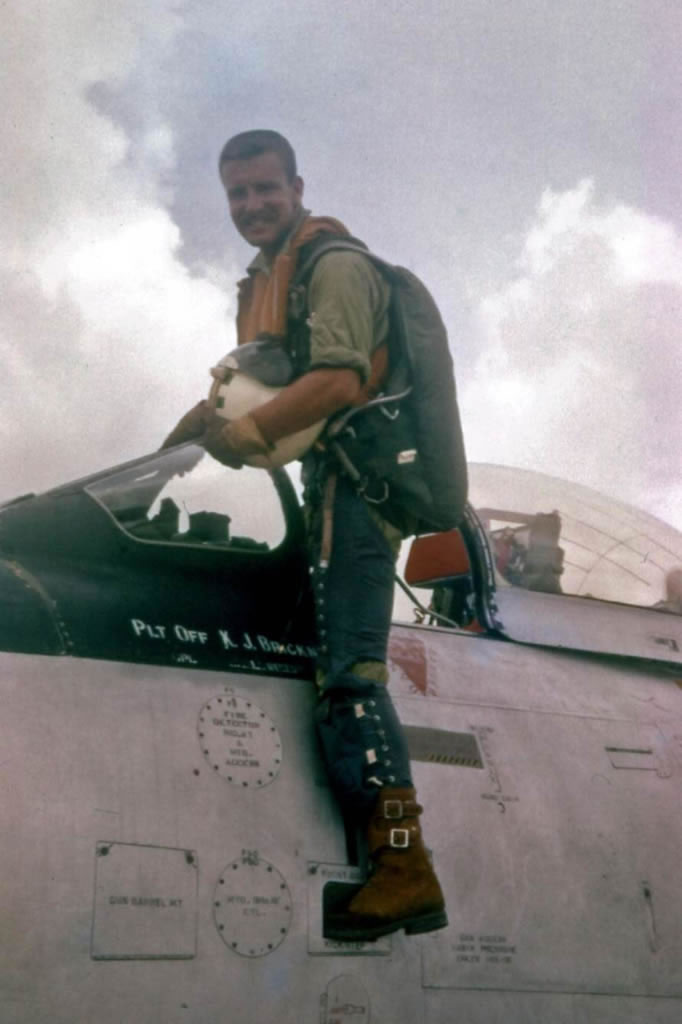
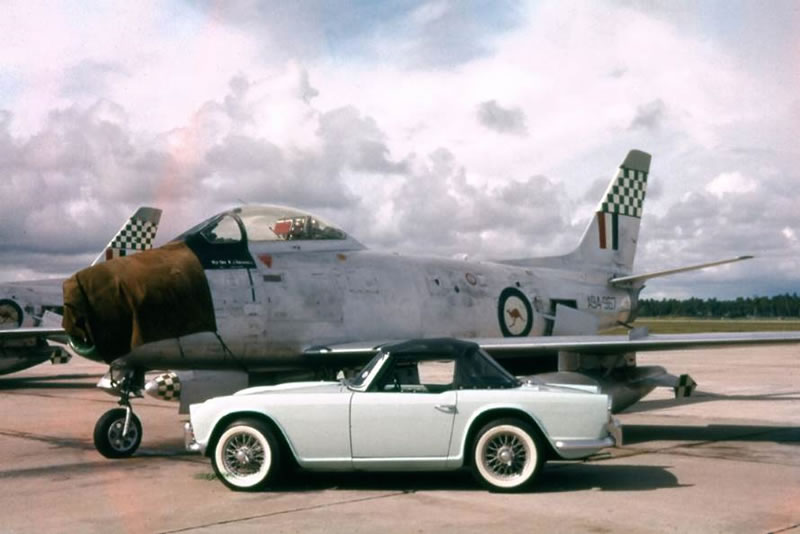
© Eric Galliers 2016
This article was published on Saturday, June 04 2016; Last modified on Saturday, June 04 2016

